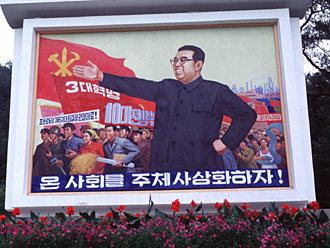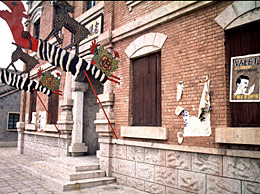Cinema Stupido
In Pyongyang's state film studio, the director always pleads to play it again Kim, because the Great Leader is not only the liberator of this self-proclaimed People's Paradise, he's also the only leading man for the paranoid but productive propaganda unit
By Ron Gluckman /Pyongyang, North Korea
MICHAELS CAINE AND DOUGLAS ARE OUTDISTANCED every day, and even strongmen Stallone and Schwarzenegger combined couldn't hold a candle to the Great Leader, who is the world's leading-est leading man. He has every juicy part, every great line. No matter whether the script is for a western, war flick or modern movie, the outcome is always the same: the Great Actor wins every time.
 In the hills a few miles west of North Korea' capital, time and sense
are scattered. Students riot in the streets of a South Korea university. The proud,
courageous Korean rebels still battle the brutal Japanese oppressors. Workers overthrow
the capitalistic labor lords. And, invariably, the same hero prevails in every story.
In the hills a few miles west of North Korea' capital, time and sense
are scattered. Students riot in the streets of a South Korea university. The proud,
courageous Korean rebels still battle the brutal Japanese oppressors. Workers overthrow
the capitalistic labor lords. And, invariably, the same hero prevails in every story.
Outside North Korea, he may be unsung, but on his home turf, Kim Il Sung the world's longest reigning dictator, has total script control. At the Korean Feature Film Studio, overseen by Sung's son and dictator-in-waiting, Kim Jong Il, who has added the humble title of "Genius of the Cinema" to the official one of Dear Leader, papa Sung is the star of nearly every state-produced film, an Asian Erroll Flynn, Humphrey Bogart and Johnny Weismuller all rolled into one.
But make no mistake, these are no mainstream dramas. The title list includes "Sea of Blood," "The Fate of a Self-Defense Corps Man," "Flames Spreading Over the Land," "The County Party Chief Secretary," "Five Guerilla Brothers" and "The Path to Awakening."
The studio turned out its first feature film, "My Homeland," in 1949, three years after Kim Il Sung assumed power in North Korea. Nowadays, the sprawling studio west of Pyongyang produces about 40 films annually, with six other facilities wrapping an additional 40 features every year.
State-run studios run on schedules that would make Steven Spielberg swoon. During a visit in July (1991), actors were engaged in a landmark 30-part series under the working title of "The Nation and the Individual Fate," the most ambitious presentation of Kim Il Sung's personal philosophy, known as the Juche ideal. The director said they would wrap all 30 segments within two years.
Of course, there is no overtime in an industry where roles and scripts are dictated by the dictator's son himself. Kim junior has visited the studio 340 times, according to its administrator. He reportedly eschews sleep so he can rewrite scripts overnight that miraculously emerge as masterpieces, according to local lore. Nobody knows if the tantrum of stars are one-way tickets to the extensive labor camps closed to the outside world.
In fact, stars have no promotional tours to attend. When the final cuts are completed, the actors move to the nearby farmland and help harvest the crops, according to the "Guide to the Korean Film Studio," which praises the process thusly: "Film artists go into reality. They help farmers in their work at the rice-transplanting season."
This is Hollywood fantasy played to its farthest reaches. Whether there is even a shred of truth to the tales is difficult to ascertain, since contact with the actors is only allowed in the presence of party officials. "We are lucky to be doing our part to contribute to the culture and enjoyment of the people," says one through a tourist translator.
"Actors work eight hours per day," says studio administrator Ri Jong-Duk. "We combine work with relaxation, so they have very good conditions, much better than in the West."
North Korean films seldom circulate outside the country, although many have been screened at socialist film festivals. Yet they are widely seen within the country, either in the state-run cinemas or repeatedly upon the nation's two television channels. No outside television programming is allowed in North Korea and all radios are sold with dials fixed to state stations.
Jong-Duk says directors can view western films, but are not influenced by outside techniques or themes, which he termed inappropriate. "Any feature film that contributes to people's lives is good, but those that do not represent the ideals of the people, such as those that talk about robbery or despair, are not accepted."
The expansion of the North Korean film industry results from a mandate from the Dear Leader, who dictates the direction of the state cinema. "Films should be popular and national in content and form as required by the era of independence when the people have emerged as masters of the world and that the system and method of its creation should be renewed in our own way," Kim is quoted in the June 1991 issue of Korea magazine.
"His theory of film making is famous," says Jong-Duk. "The Genius gives his personal guidance to everything we do. Before his guidance, our films were like Russian feature films, like Chinese feature films. Under his guidance, we have created Korean feature films. He invented new theories that changed the cinema."
The formula is straight forward. Koreans are always the good guys, triumphing over evil outside repression. The villains are the Japanese, the Americans, the south Koreans or the Chinese, depending on the time frame.
 All that changes is the set and the approach to the same subject. The
largest set is an old frontier town full of pubs, barber shops and girlie bars. It
measures 750,000 square meters and sports 220 buildings. Signs can be changed from Korean
to Japanese and facades altered to fit the particular piece.
All that changes is the set and the approach to the same subject. The
largest set is an old frontier town full of pubs, barber shops and girlie bars. It
measures 750,000 square meters and sports 220 buildings. Signs can be changed from Korean
to Japanese and facades altered to fit the particular piece.
Another set is a row of ancient thatched huts, while in the hills nearby are a block of modern buildings used to depict the corruption of European or American life. The interiors, with hideous tile and carpets, would suit any horror flick.
The studio also has a railroad that can be dressed for any period. The rail is functioning and serves to supply the studio.
Everything is well maintained, with 1,200 workers in constant motion, sweeping, shoveling, pruning and cutting grass by hand.
Editing and sound production are likewise labor intensive. Equipment tends to be primitive, with much of the machinery of patchwork construction. The editing room, for instance, features a control board with knobs and dials stuck through holes cut in a common card table.
The studio's viewing room has the feel of an old gymnasium, with a few stuffed chairs lined up for VIPs. The films themselves, though, are of decent quality, if one ignores the predictable plots and savage scene cuts. One sample shown was an upcoming blockbuster about a South Korean uprising, full of action with tanks in the streets and blown-up buildings.
Two actors always portray the Great Leader, according to Jong-Duk. Kim Il Sung never plays a part himself. "Maybe in America, perhaps, where the president is an actor," he says, interjecting the only note of comedy observed at the staid North Korean studio.
Ron Gluckman is an American reporter based in Hong Kong, who roams around the nether reaches of Asia for a variety of publications, including Time, Newsweek, the Wall Street Journal, Discovery, the Sydney Morning Herald, Los Angeles Times and Asiaweek, which ran this story in September 1992. For other stories on North Korea, click on Last Tango in Paradise, Great Escape, or On the Border.
To return to the opening page and index
push here
[right.htm]
